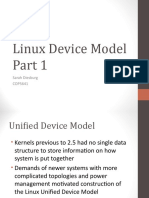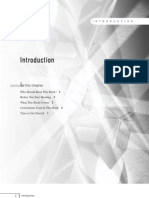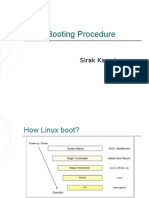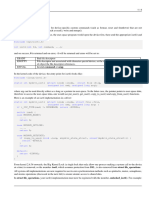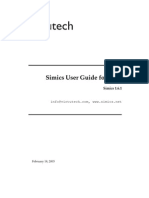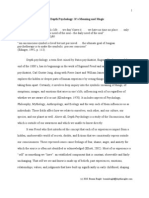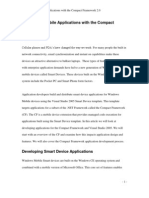0 ratings0% found this document useful (0 votes)
143 viewsLinux Presentation
Linux Presentation
Uploaded by
ssanagavThe document discusses device drivers in Linux operating systems. It covers what device drivers are, their main functions, and how they communicate with hardware devices. It also describes the two main types of device drivers - character drivers and block drivers. Character drivers allow serial access of data bytes from devices like mice and serial ports, while block drivers allow random access to blocks of data from storage devices like hard drives. The document outlines how device drivers interface with devices, handle interrupts, access device controllers, and perform input/output operations through functions defined in their file operations structures.
Copyright:
© All Rights Reserved
Available Formats
Download as PPT, PDF, TXT or read online from Scribd
Linux Presentation
Linux Presentation
Uploaded by
ssanagav0 ratings0% found this document useful (0 votes)
143 views77 pagesThe document discusses device drivers in Linux operating systems. It covers what device drivers are, their main functions, and how they communicate with hardware devices. It also describes the two main types of device drivers - character drivers and block drivers. Character drivers allow serial access of data bytes from devices like mice and serial ports, while block drivers allow random access to blocks of data from storage devices like hard drives. The document outlines how device drivers interface with devices, handle interrupts, access device controllers, and perform input/output operations through functions defined in their file operations structures.
Original Description:
DD
Copyright
© © All Rights Reserved
Available Formats
PPT, PDF, TXT or read online from Scribd
Share this document
Did you find this document useful?
Is this content inappropriate?
The document discusses device drivers in Linux operating systems. It covers what device drivers are, their main functions, and how they communicate with hardware devices. It also describes the two main types of device drivers - character drivers and block drivers. Character drivers allow serial access of data bytes from devices like mice and serial ports, while block drivers allow random access to blocks of data from storage devices like hard drives. The document outlines how device drivers interface with devices, handle interrupts, access device controllers, and perform input/output operations through functions defined in their file operations structures.
Copyright:
© All Rights Reserved
Available Formats
Download as PPT, PDF, TXT or read online from Scribd
Download as ppt, pdf, or txt
0 ratings0% found this document useful (0 votes)
143 views77 pagesLinux Presentation
Linux Presentation
Uploaded by
ssanagavThe document discusses device drivers in Linux operating systems. It covers what device drivers are, their main functions, and how they communicate with hardware devices. It also describes the two main types of device drivers - character drivers and block drivers. Character drivers allow serial access of data bytes from devices like mice and serial ports, while block drivers allow random access to blocks of data from storage devices like hard drives. The document outlines how device drivers interface with devices, handle interrupts, access device controllers, and perform input/output operations through functions defined in their file operations structures.
Copyright:
© All Rights Reserved
Available Formats
Download as PPT, PDF, TXT or read online from Scribd
Download as ppt, pdf, or txt
You are on page 1of 77
The Story of Device Drivers
Ankush Garg, Dheeraj Mehra, Rohan Paul,Vaibhav
Anand Silodia, Rohit Prakash
What are Device Drivers ?
What does a Device Driver do ?
A set of routines that communicate with a hardware
device and provide a uniform interface to the operating
system kernel
A self-contained component that can be added to, or
removed from, the operating system dynamically.
Management of data flow and control between user
programs and a peripheral device.
A user-defined section of the kernel that allows a
program or a peripheral device to appear as a `` /dev ''
device to the rest of the system's software.
Within the Kernel
DD resides in the Kernel - service interrupts
- access device hardware
DD has two sections - interrupt section (real time events)
- synchronous section (process must be exec)
What happens to requesting process ?
interruptible_sleep_on(&dev_wait_queue)
wake_up_interruptible(&dev_wait_queue)
Synschronization
cli() // clear interrupts
Critical Section Operations
sti () // set interrupt enable
File Operations
Devices are accessed as files
Simply nodes of the filesystem tree; they are conventionally located in the
/dev directory
Applications use standard system calls to open them, read from them,
write to them and close them exactly as if the device were a file.
Each Device Driver registers by adding an entry into chrdevs vector
Device's major device identifier is used as an index into this vector.
(for example 4 for the tty device)
Major number for a device is fixed.
Types
Character Devices
- allows serial access of data bytes
- Mice, Keyboard, Serial Port, et cetera
Block Devices
- transfers a block of bytes as a unit
- allows random access to independent, fixed sized blocks of data
- hard drive, cd-rom, et cetera
Network Devices
- dealt differently from the above two
- users cant directly transfer data to network devices
- communicate indirectly by opening a connection to the kernels
networking system.
Device Controller
It is a collection of electronics that can operate a
port, a bus or a device.
I/O devices have components:
mechanical component
electronic component Device Controller
Task
convert serial bit stream to block of bytes
perform error correction as necessary
How do Device drivers access
the Controller
By reading and writing bit patters in specific registers of
the controller.
1) Special I/O Instructions
Triggers bus lines to select the proper device and to move bits
into /out of a device register.
Valid only in kernel mode, No longer popular
2) Memory-mapped I/O
Registers mapped to address space of processor
Read and write to special memory addresses
Protect by placing in kernel address space only
May map part of device in user address space for faster access
Polling
Processor: Controller Producer: Consumer
Two bits used for handshaking
1) Busy bit controller status
2) Command ready bit set by host when
command ready for execution
Linux's floppy drive uses polling
Polling by means of timers is at best
approximate
Interrupt
Device raises an interrupt when it needs to be
serviced
Interrupts being used - /proc/interrupts
Types
Fixed, Floppy Disk Controller always uses
interrupt 6
Allocated at boot time, PCI interrupts
Other interrupts stopped when an interrupt is
delivered
Interrupts cont...
Earlier
- 16 interrupt lines
- one processor to deal with them.
Modern hardware
- more interrupts,
- equipped with advanced programmable interrupt
controllers (APICs)
- can distribute interrupts across multiple processors in
an intelligent (and programmable) way.
Interrupt driven I/O
Semantics for generating Interrupts
Input:
a) device interrupts the processor when new data has arrived
b) actual actions to perform depend on whether the device uses
I/O ports, memory mapping, or DMA.
Output:
a) device delivers interrupt when ready to accept new data or to
acknowledge a successful data transfer.
b) Memory-mapped and DMA-capable devices usually generate
interrupts to tell the system they are done with the buffer.
Device Driver Interface
Device Driver Interface
Understanding Character
Device Drivers
What is a character device
The simplest of Linux's devices
Transfers bytes one by one (compare with block)
Referenced by standard system call (get() , put())
like open , read ,close etc
Standard examples
/dev/null
virtual terminals (ttys)
serial port
keyboard
sound
ls l in /dev
Char Device
Major Num
Minor Num
The major number identifies the driver associated with the device
Driver can control several devices => minor number used to
differentiate among them.
Registering a char device
Registering
int register_chrdev (unsigned int major, const char *name,
struct file_operations *fops);
Removing a device
int unregister_chrdev (unsigned int major, const char *name);
Create a device node on a file system
mknod /dev/scull0 c 254 0
Major No
Minor No
Char device
File operations
Vector of char devices
Indexed
by the
Major no
File operations
struct file_operations
{
int (*lseek)(...);
int (*read)(...);
int (*write)(...);
int (*select)(...);
int (*ioctl)(...) . . .
int (*open)(...);
int (*release)(...);
. . .
};
Array of function pointers
or
Set as NULL
Pointer to
lseek Changes current r/w pos in a file, Returns the new position
read Used to retrieve data from the device
write Sends data to the device.
readdir NULL for device, Used for Filesystems
poll Inquire if a device is readable or writable or in some special state
ioctl issue device-specific commands e.g. Format a floppy disk
mmap request a mapping of device memory to a process's addr space
open First operation, Not needed for Device Drivers
File operations
Mapping calls to dev functions
Use of semaphores
int xxx_open(struct inode *inode, struct file *filp)
{ int num = NUM(inode->i_rdev);
int type = TYPE(inode->i_rdev);
MOD_INC_USE_COUNT; /* Before we maybe sleep */
if (down_interruptible(&dev->sem)) {
MOD_DEC_USE_COUNT;
return -ERESTARTSYS;
}
up(&dev->sem);
}
return 0; /* success */
lock
Release lock
Semaphores
Since the devices are entirely independent of each other, there is no need
to enforce mutual exclusion across multiple devices.
The down_interruptible function can be interrupted by a signal, whereas
down will not allow signals to be delivered to the process
down_interruptible why?
Otherwise risk creating unkillable processes
Why?
To handle Race conditions
Read() and write()
Understanding Block Drivers
Registering a device
Block drivers : identified by major numbers
Block major numbers are entirely distinct from char major numbers
A block device with major number 32 can coexist with a char
device using the same major number since the two ranges are
separate
Commands to register
int register_blkdev (unsigned int major, const char *name,
struct block_device_operations *bdops);
int unregister_blkdev (unsigned int major, const char *name);
Block Device Operations
struct block_device_operations {
int (*open) (struct inode *inode,struct file *filp);
int (*release) (struct inode *inode, struct file *filp);
int (*ioctl) (struct inode *inode, struct file *filp, unsigned command,
unsigned long argument);
int (*check_media_change) (kdev_t dev);
int (*revalidate) (kdev_t dev); };
There are no read or write operations provided in the
block_device_operations structure.
All I/O to block devices is normally buffered by the
system
Block Devices : How I/O is done
Define request function
request function is with the queue of pending I/O operations for the
device. By default
There is one such queue for each major number.
A block driver must initialize that queue with blk_init_queue.
Queue accessed by major number : BLK_DEFAULT_QUEUE(major)
This macro looks into a global array of blk_dev_struct structures
called blk_dev, which is maintained by the kernel and indexed by
major number
struct blk_dev_struct
{
request_queue_t request_queue;
queue_proc *queue;
void *data; };
Queue we
initialised
Information from Kernel
Global arrays hold information about block drivers.
int blk_size[ ][ ]; describes the size of each device
int blksize_size[ ][ ]; size of the block used by each device, in
bytes
int read_ahead[ ]; number of sectors to be read in advance
by the kernel
int max_sectors[ ][ ]; array limits the maximum size of a single
request
int max_segments[ ]; number of individual segments that could
appear in a clustered request
Header File blk.h
All block drivers must include the header file <linux/blk.h>
This file defines much of the common code that is used in
block drivers, and it provides functions for dealing with the I/O
request queue
MAJOR_NR, DEVICE_NAME, DEVICE_NR (kdev_t device)
device specific fields must be defined before including
Request Function
The Request Queue
When the kernel schedules a data transfer, it queues the
request in a list, ordered in such a way that it maximizes
system performance.
The queue of requests is then passed to the driver's request
function, which has the following prototype:
void request_fn (request_queue_t *queue);
What does request do ?
1) Checks validity of the request (INIT_REQUEST )
2) Performs the actual data transfer
(The CURRENT variable( macro) can be used to retrieve
the details of the current request)
3) Cleans up the request just processed. (end_request)
4) Loops back to the beginning, to consume the next request
Minimal request function
void sbull_request (request_queue_t *q)
{ while(1)
{ INIT_REQUEST;
printk("<1>request %p: cmd %i sec %li (nr. %li)\n",
CURRENT, CURRENT->cmd,
CURRENT->sector,
CURRENT->current_nr_sectors);
end_request(1);
/* success */ }
}
Request Queue
Data Transfer
By accessing the fields in the request structure, usually by way of
CURRENT, the driver can retrieve all the information needed to transfer
data between the buffer cache and the physical block device
CURRENT is just a pointer to blk_dev[MAJOR_NR].request_queue
Important Fields
- kdev_t rq_dev : The device accessed by the request
- int cmd : Operation to be performed; Read or Write
- unsigned long sector: The number of the first sector to be
transferredin this equest
- char *buffer: The area in the buffer cache to which data should
be written/ read
Making Accesses Faster
Clustering
Clustering of requests to adjacent sectors on the disk.
Modern filesystems will attempt to lay out files in
consecutive sectors
=> requests to adjoining parts of the disk are common.
Elevator'' algorithm
An elevator in a skyscraper is either going up or down; it will
continue to move In those directions until all of its "requests''
(people wanting on or off) have been satisfied.
In the same way, the kernel tries to keep the disk head
moving in the same direction for as long as possible
=> minimize seek times and increase throughput
How Clustering Works
Block driver must look directly at the list of buffer_head structures
attached to the request.
This list is pointed to by CURRENT->bh; subsequent buffers can be
found by following the b_reqnext pointers in each buffer_head structure.
Algorithm
1) Arrange to transfer the data block at address bh->b_data,
of size bh->b_size bytes.
The direction of the data transfer is CURRENT->cmd (READ/ WRITE).
2) Retrieve the next buffer head in the list: bh->b_reqnext.
Then detach the buffer just transferred from the list, by zeroing its
b_reqnext -- the pointer to the new buffer you just retrieved.
How Clustering Works
3) Update the request structure to reflect the I/O done with the buffer that
has just been removed.
Both CURRENT->hard_nr_sectors and CURRENT->nr_sectors should
be decremented by the number of sectors (not blocks) transferred from
the buffer.
4) The sector numbers CURRENT->hard_sector and CURRENT->sector
should be incremented by the same amount.
5) Loop back to the beginning to transfer the next adjacent block.
After I/O completes notify the kenel by calling the buffer's I/O completion
routine: bh->b_end_io(bh, status);
Making Accesses Faster
Scatter Gather
The "scatter" part means that when there are multiple
blocks to be written all over a disk
Example
one command is sent out to initiate writing to all those
different sectors, reducing the overhead involved in
negotiation from O(n) to O(1), where n is the number of
blocks or sectors to write.
Gather part means that when there are multiple blocks to
be read, one command is sent out to initiate reading all the
blocks, and as the disk sends in each block, the
corresponding request is marked as satisfied with
end_request(1).
Buffers in the I/O Request Queue
Understanding DMA
What is DMA
DMA is the hardware mechanism that allows peripheral
components to transfer their I/O data directly to and
from main memory without the need for the system
processor to be involved in the transfer.
Use of this mechanism can greatly increase throughput
to and from a device
What is DMA
Hardware mechanism
Allows peripheral components to transfer their I/O data
directly to and from main memory without the need for
the system processor to be involved in the transfer
Use of this mechanism can greatly increase throughput
to and from a device
Device driver needs to be able to correctly set up the
DMA transfer and synchronize with the hardware
DMA is very system dependent
When is DMA needed
Data transfer can be triggered in two ways:
1) Software asks for data (via a function such as read)
1) Hardware asynchronously pushes data to the system.
Case I : Software asks for data
When a process calls read, the driver method allocates
a DMA buffer and instructs the hardware to transfer its
data. The process is put to sleep.
The hardware writes data to the DMA buffer and raises
an interrupt when it's done.
The interrupt handler gets the input data,
acknowledges the interrupt, and awakens the process,
which is now able to read data.
Case II : Asynchronous DMA
The hardware raises an interrupt to announce that new
data has arrived.
The interrupt handler allocates a buffer and tells the
hardware where to transfer its data.
The peripheral device writes the data to the buffer and
raises another interrupt when it's done.
The handler dispatches the new data, wakes any
relevant process, and takes care of housekeeping.
Case III : Network Cards
These cards often expect to see a circular buffer (often
called a DMA ring buffer) established in memory
shared with the processor
Each incoming packet is placed in the next available
buffer in the ring, and an interrupt is signaled.
The driver then passes the network packets to the rest
of the kernel, and places a new DMA buffer in the ring.
Allocating DMA Buffers
The main problem with the DMA buffer is that when it is
bigger than one page
It must occupy contiguous pages in physical memory
because the device transfers data using the ISA or PCI
system bus, both of which carry physical addresses.
Bus Addresses
A device driver using DMA has to talk to hardware connected to
the interface bus, which uses physical addresses, whereas
program code uses virtual addresses.
Solution
unsigned long virt_to_bus(volatile void * address);
void * bus_to_virt(unsigned long address);
virt_to_bus conversion must be used when the driver needs to
send address information to an I/O device (such as an expansion
board or the DMA controller)
bus_to_virt must be used when address information is received
from hardware connected to the bus.
DMA Mappings
A DMA mapping is a combination of
- Allocating a DMA buffer
- Generating an address for that buffer that is
accessible by the device
Mapping Registers (virtual memory for peripherals)
1) Peripherals have a relatively small, dedicated range
of addresses to which they may perform DMA
2) Those addresses are remapped, via the mapping
registers, into system RAM.
3) Have ability to make several distributed pages
appear contiguous in the device's address space.
DMA Mappings
Bounce Buffer
1) Bounce buffers are created when a driver
attempts to perform DMA on an address that
is not reachable by the peripheral device
eg., a high-memory address
2) Data is then copied to and from the bounce
buffer as needed.
Registering DMA Usage
int request_dma(unsigned int channel, const char *name);
void free_dma(unsigned int channel);
The channel argument is a number between 0 and 7 or,
more precisely, a positive number less than
MAX_DMA_CHANNELS.
DMA: a shared Resource
unsigned long claim_dma_lock()
Acquires the DMA spinlock.
This function also blocks interrupts on the local processor
thus the return value is the usual "flags'' value, which
must be used when reenabling interrupts.
void release_dma_lock(unsigned long flags
Some more stuff
PCI
PCI Buses & Bridges
Glue connecting the system components
together
PCI device driver A function of OS called at
system initialization time
PCI initialization code scans all PCI buses
looking for all PCI devices
Depth-wise recursive algorithm to assign
numbers to PCI-bridges
Network Device Drivers
Attaches a network subsystem to a network
interface
Difference from Block devices Interacts with
the outside world
Prepares the network interface for operation,
transmission and reception of network frames
Sets addresses, modifies transmission
parameters and maintaining traffic statistics
Network Device Drivers
Transmission Timeouts for Network Devices
Hardware may fail drivers must be prepared.
Problem of missing Interrupts - solved by using a mass
of timers.
Any Network system is a complicated assembly of state
machines controlled by a mass of timers.
Networking code level best position to detect
transmission timeouts.
Thus, Network drivers need not worry.
Understanding Timers
Timer Interrupt
The mechanism used by the kernel to keep track of
time intervals
Generated by the system's timing hardware at
regular intervals
1) interval is set by the kernel according to the
value of HZ, which is an architecture-dependent
value defined in <linux/param.h
2) Current Linux versions define HZ to be 100 for
most platforms.
Mechanism
Jiffies
o the number of clock ticks since the computer was
turned on
o declared in <linux/sched.h> as unsigned long
volatile
o Generally sufficient for measuring time intervals
(according to the least count)
Counter Register
Counter register is steadily incremented once at each
clock cycle.
Platform dependent
may or may not be writable
may or may not be readable from user space
64 or 32 bits wide
Used for measuring very short time lapses with
precision
TSC (timestamp counter)
Introduced in x86 processors with the
Pentium and present in all CPU designs
ever since
64-bit register that counts CPU clock cycles
can be read from both kernel space and
user space
Scheduling tasks at a later time without
using interrupts
Three interfaces are available
Task queues
Tasklets
Kernel timers
Task queues
It is a list of tasks, each task being represented
by a function pointer and an argument
A queue element is described by the following
structure, copied directly from
<linux/tqueue.h>:
struct tq_struct {
struct tq_struct *next;
int sync; /* must be initialized to zero */
void (*routine)(void *); /* function to call */
void *data; /* argument to function */
};
Task queues
Different queues are run at different times, but they are
always run when the kernel has no other pressing
work to do
Almost never run when the process that queued the
task is executing
Often run as the result of a software interrupt
A task can requeue itself in the same queue from
which it was run
Predefined task queues
Driver can use only three :
The scheduler queue
unique among the predefined task queues in that it runs in
process context, implying that the tasks it runs have a bit
more freedom in what they can do
tq_timer
run by the timer tick. Because the tick (the function
do_timer) runs at interrupt time, any task within this queue
runs at interrupt time as well.
tq_immediate
The immediate queue is run as soon as possible, either on
return from a system call or when the scheduler is run,
whichever comes first. The queue is consumed at interrupt
time.
Task queues
Tasklets
Way of deferring a task until a safe time, and they are
always run in interrupt time
Tasklets will be run only once, even if scheduled
multiple times
May be run in parallel with other tasklets on SMP
systems
Each tasklet has associated with it a function that is
called when the tasklet is to be executed
Tasklets
DECLARE_TASKLET (name, function, data);
Declares a tasklet with the given name; when the tasklet is to
be executed, the given function is called with the (unsigned
long) data value
DECLARE_TASKLET_DISABLED (name, function, data);
Declares a tasklet as before, but its initial state is "disabled,''
meaning that it can be scheduled but will not be executed until
enabled at some future time.
Kernel Timers
Timers are used to schedule execution of a function (a
timer handler) at a particular time in the future
We can specify exactly when in the future the function
will be called
You register your function once, and the kernel calls it
when the timer expires
Function registered in a kernel timer is executed only
once
Kernel Timers
Once a timer_list structure is initialized, add_timer
inserts it into a sorted list, which is then polled more or
less 100 times per second
Race conditions
the timer expires at just the right time, even if the
processor is executing in a system call
Any data structures accessed by the timer function
should be protected from concurrent access
To avoid race conditions while deleting the timers,
one must use del_timer_sync instead of del_timer.
Thank You
You might also like
- Private Metaapi Python LibDocument36 pagesPrivate Metaapi Python LibKiran RNo ratings yet
- Stern Forms of VitalityDocument10 pagesStern Forms of Vitalityssanagav100% (2)
- Microservices For Everyone Sample PDFDocument49 pagesMicroservices For Everyone Sample PDFJelena MalinovićNo ratings yet
- Easy8051 v6 Development SystemDocument4 pagesEasy8051 v6 Development SystemShobhit SinghNo ratings yet
- Crash N' Burn: Writing Linux Application Fault HandlersDocument25 pagesCrash N' Burn: Writing Linux Application Fault HandlersTuxology.net100% (4)
- Non-Aristotelian Logic in PracticeDocument14 pagesNon-Aristotelian Logic in PracticessanagavNo ratings yet
- 8 - Character Device DriversDocument44 pages8 - Character Device Driversvenki_pinki100% (1)
- Character Device DriverDocument42 pagesCharacter Device DriverNaga ManjunathNo ratings yet
- Linux ToolchainDocument34 pagesLinux ToolchainDhruv ChawdaNo ratings yet
- Linux Device ModelDocument45 pagesLinux Device Modelvigneshthegreat100% (1)
- Notes - On - Linux KernelDocument2 pagesNotes - On - Linux KernelrwyqurunkcnfnmjdnyNo ratings yet
- VX Worksproject 10Document32 pagesVX Worksproject 10Abhay Kumar Sahu100% (1)
- Analyzing Kernel Crash On Red HatDocument9 pagesAnalyzing Kernel Crash On Red Hatalexms10No ratings yet
- Using Visual C++, 6th (Special) EditionDocument882 pagesUsing Visual C++, 6th (Special) Editionapi-3867212100% (2)
- 6 Device Driver ControllerDocument32 pages6 Device Driver ControllerEdson Pires da Silva100% (1)
- Kernel Overview: Differences Between Kernel Modules and User ProgramsDocument12 pagesKernel Overview: Differences Between Kernel Modules and User ProgramsvirendrakumarthakurNo ratings yet
- Very Simple Threading ExampleDocument38 pagesVery Simple Threading ExamplephanishyamnagaNo ratings yet
- CS Students Linux User's Guide: Writing A MakefileDocument7 pagesCS Students Linux User's Guide: Writing A MakefilewildgbirdNo ratings yet
- An Introduction To GCCDocument4 pagesAn Introduction To GCCbrad100% (1)
- Linux Booting Procedure: Sirak KaewjamnongDocument39 pagesLinux Booting Procedure: Sirak Kaewjamnongamsreeku100% (1)
- Direct Kernel Object ManipulationDocument45 pagesDirect Kernel Object ManipulationCameron DeanNo ratings yet
- Lab 06Document4 pagesLab 06xyzs8386100% (1)
- (Ebook - Electronics) Introduction To Microcontrollers - Complete Guide To PICDocument230 pages(Ebook - Electronics) Introduction To Microcontrollers - Complete Guide To PICSiva100% (9)
- Lecture MakefileDocument26 pagesLecture MakefileJosef CavalirNo ratings yet
- Introduction To Uclinux: Michael Opdenacker Free ElectronsDocument50 pagesIntroduction To Uclinux: Michael Opdenacker Free Electronsresonence123No ratings yet
- C++ Summarized NotesDocument32 pagesC++ Summarized Noteschandni1972100% (1)
- Writing Device Drivers in LinuxDocument35 pagesWriting Device Drivers in Linuxtnj_dineshNo ratings yet
- Debugging The Linux Kernel With Sourcery CodeBench and Mentor Embedded Sourcery ProbeDocument11 pagesDebugging The Linux Kernel With Sourcery CodeBench and Mentor Embedded Sourcery Probeमेनसन लाखेमरूNo ratings yet
- Drivers LinuxDocument57 pagesDrivers Linuxyashgaya3No ratings yet
- IntelAcademic IoT 07 C-CPP YoctoDocument23 pagesIntelAcademic IoT 07 C-CPP Yoctogabrielw6No ratings yet
- 3.2 Rtlinux Inter-Process Communication (Ipc)Document8 pages3.2 Rtlinux Inter-Process Communication (Ipc)ravirajsjoshiNo ratings yet
- Embedded Linux Systems With The Yocto Projects PresentationDocument64 pagesEmbedded Linux Systems With The Yocto Projects PresentationBill GatesNo ratings yet
- I2c PaperDocument14 pagesI2c PaperParvinder SinghNo ratings yet
- Linux GDB CommandsDocument10 pagesLinux GDB CommandsBipin JaiswalNo ratings yet
- All About Linux Signals - Linux Programming BlogDocument20 pagesAll About Linux Signals - Linux Programming BlogBattula Yagna Srinath ReddyNo ratings yet
- Basics of Embedded LinuxDocument55 pagesBasics of Embedded Linuxvansi84No ratings yet
- Debugging Tools Intro - DWARF, ELF, GDB:Binutils, Build-IdDocument33 pagesDebugging Tools Intro - DWARF, ELF, GDB:Binutils, Build-IdergodicNo ratings yet
- OpenWrt SDKDocument10 pagesOpenWrt SDKSailajaUngatiNo ratings yet
- GCC Profile Guided OptimizationDocument47 pagesGCC Profile Guided OptimizationTuxology.netNo ratings yet
- Cross Compiler & Assembler & LinkerDocument37 pagesCross Compiler & Assembler & Linkervarun2313676No ratings yet
- Virtio 1.0: Paravirtualized I/O For KVM and BeyondDocument15 pagesVirtio 1.0: Paravirtualized I/O For KVM and BeyondMehmet DemirNo ratings yet
- Filesystem PDFDocument50 pagesFilesystem PDFRaja Shahbaz KhalidNo ratings yet
- Linux Kernel SlidesDocument473 pagesLinux Kernel SlideslingeshtjNo ratings yet
- Linux Hardware ManagementDocument26 pagesLinux Hardware ManagementSergey KryazhevNo ratings yet
- Tutorial On Linux Device Driver: 1 BasicsDocument6 pagesTutorial On Linux Device Driver: 1 BasicscartamenesNo ratings yet
- Embedded Linux RealtimeDocument76 pagesEmbedded Linux RealtimeLenon Raubach TuchtenhagenNo ratings yet
- Cross Toolchain For ARMDocument13 pagesCross Toolchain For ARMLuis Alberto SierraNo ratings yet
- Crash Dump Analysis: Debugging in WindowsDocument28 pagesCrash Dump Analysis: Debugging in WindowsVenkataramana AnsNo ratings yet
- Simics User Guide For LinuxDocument166 pagesSimics User Guide For Linuxlohit24No ratings yet
- C++ PracticalDocument107 pagesC++ PracticalShaikhAmnaNo ratings yet
- Userspace Networking: Beyond The Kernel Bypass With RDMA!Document8 pagesUserspace Networking: Beyond The Kernel Bypass With RDMA!aashutosh1No ratings yet
- UCD Linux Security ChecklistDocument5 pagesUCD Linux Security ChecklisttestNo ratings yet
- Booting and Shutting DownDocument97 pagesBooting and Shutting DownRehan HalaiNo ratings yet
- Python Continuous Integration and Delivery: A Concise Guide with ExamplesFrom EverandPython Continuous Integration and Delivery: A Concise Guide with ExamplesNo ratings yet
- Class 3Document37 pagesClass 3api-3774180No ratings yet
- Unix InternalsDocument21 pagesUnix Internalssriramsubramanian09No ratings yet
- Device DriversDocument46 pagesDevice DriversAsad ButtNo ratings yet
- Device DriversDocument31 pagesDevice DriversVijay KrishnaNo ratings yet
- Linux Device Driver: Nctu Os Lab Chi-Wei YangDocument14 pagesLinux Device Driver: Nctu Os Lab Chi-Wei YangNguyenVan ThanhNo ratings yet
- Linux Device DriversDocument39 pagesLinux Device Driverscoolsam.sab100% (1)
- Char Device DriverDocument22 pagesChar Device DriverQuốc KhánhNo ratings yet
- Linux Tutorial 1Document16 pagesLinux Tutorial 1ssanagavNo ratings yet
- Girls NameDocument57 pagesGirls NameDinesh Rajan D100% (1)
- English Telugu Dictionary Sankaranarayana GoogleDocument931 pagesEnglish Telugu Dictionary Sankaranarayana GooglerowthuNo ratings yet
- Nietzsche and ZenDocument128 pagesNietzsche and ZenAlexandra Maria NeaguNo ratings yet
- Girls NameDocument57 pagesGirls NameDinesh Rajan D100% (1)
- Firmative MoralityDocument16 pagesFirmative Moralityjosh6692No ratings yet
- Attention and EffortDocument253 pagesAttention and EffortGreg McKennaNo ratings yet
- Kohut H. The Disorders of The Self and Their Treatment Int.J.psychoa. Vol.59p.4131978Document13 pagesKohut H. The Disorders of The Self and Their Treatment Int.J.psychoa. Vol.59p.4131978ssanagav0% (1)
- Nondual Awareness, Dualistic Consciousness, and The Path To Absolute SanityDocument11 pagesNondual Awareness, Dualistic Consciousness, and The Path To Absolute SanityssanagavNo ratings yet
- ProprioceptionDocument142 pagesProprioceptionssanagavNo ratings yet
- Polanyi 2006 08 Lecture3 PDFDocument15 pagesPolanyi 2006 08 Lecture3 PDFssanagavNo ratings yet
- On Depth PsychologyDocument13 pagesOn Depth PsychologyssanagavNo ratings yet
- Artyom Beilis ExplannationDocument2 pagesArtyom Beilis ExplannationeliaezekielNo ratings yet
- Unity ReplicationDocument56 pagesUnity ReplicationRatataNo ratings yet
- Aysnchronous ApexDocument18 pagesAysnchronous Apexpadishalaradhika552No ratings yet
- Web ReactiveDocument175 pagesWeb Reactivemani kanta swamyNo ratings yet
- Network ProgrammingDocument168 pagesNetwork ProgrammingNoorullah Shariff100% (1)
- Cheat Sheet: Eclipse Vert.x: 4. Timer and Periodic Tasks 5. HTTPDocument12 pagesCheat Sheet: Eclipse Vert.x: 4. Timer and Periodic Tasks 5. HTTPAmine CaiusNo ratings yet
- 2013 - CoppeliaSim IROSDocument6 pages2013 - CoppeliaSim IROSRODNEY KEVIN CHACHA PASTASNo ratings yet
- EC2303 2 Marks With AnswersDocument19 pagesEC2303 2 Marks With AnswersVijay Arunagiri ANo ratings yet
- Little Javascript Preview 07 2019Document93 pagesLittle Javascript Preview 07 2019JCNo ratings yet
- Mss 6 2 Cust Ext Dev RefDocument110 pagesMss 6 2 Cust Ext Dev RefJuan Esteban Jaramillo MNo ratings yet
- MobcfappsDocument48 pagesMobcfappsHarshitha ShivalingacharNo ratings yet
- Native API Tour Rev CDocument25 pagesNative API Tour Rev CzbouzghaNo ratings yet
- FreeRTOS - TasksDocument31 pagesFreeRTOS - TasksMani Kandan KNo ratings yet
- FreeRTOS - TasksDocument31 pagesFreeRTOS - TasksMani Kandan KNo ratings yet
- UNIT IV - IO Management - Disk SchedulingDocument11 pagesUNIT IV - IO Management - Disk SchedulingMoloy ChatterjeeNo ratings yet
- Netty in Action v9 MEAP PDFDocument296 pagesNetty in Action v9 MEAP PDFМаксим ПетровNo ratings yet
- Completer in Dart Flutter A Powerful Tool For Asynchronous ProgrammingDocument6 pagesCompleter in Dart Flutter A Powerful Tool For Asynchronous Programmingشہزاد رحیمNo ratings yet
- s71500 CM PTP Function Manual en-US en-USDocument188 pagess71500 CM PTP Function Manual en-US en-USmineotservNo ratings yet
- Node Js DocumentDocument2 pagesNode Js DocumentjayantNo ratings yet
- Java Notes 3Document523 pagesJava Notes 3Ashok KaryampudiNo ratings yet
- Vimba ManualDocument59 pagesVimba ManualXuan ArbasNo ratings yet
- Performance Testing With GatlingDocument41 pagesPerformance Testing With GatlingJuan Perez100% (1)
- Ice Faces Developers GuideDocument131 pagesIce Faces Developers GuidetakotakNo ratings yet
- Brahmastra: Driving Apps To Test The Security of Third-Party ComponentsDocument17 pagesBrahmastra: Driving Apps To Test The Security of Third-Party Componentsdevid mandefroNo ratings yet
- Block RAMDocument17 pagesBlock RAMTiniNo ratings yet
- Dart Cookbook Sample ChapterDocument32 pagesDart Cookbook Sample ChapterPackt PublishingNo ratings yet
- Mobilink 11 Performance: A Whitepaper From Sybase Ianywhere Author: Graham Hurst Date: July 2009Document28 pagesMobilink 11 Performance: A Whitepaper From Sybase Ianywhere Author: Graham Hurst Date: July 2009vrpnacharyNo ratings yet
- JavascriptDocument12 pagesJavascriptAryan BadeNo ratings yet









